The word hybrid refers to something created by combining two different elements.
In nature, a hybrid is created by combining two different species or types of animals and plants into a completely new variety such as the brilliantly named zorse — an offspring of a zebra and a horse.
In project management, a hybrid is a custom approach created by combining predictive (Waterfall) and adaptive (Agile) methodologies to varying degrees to create a version that best suits each unique project workflow.
This blog post will further elaborate on:
- Different types of hybrid methodologies,
- Differences between adaptive, predictive, and hybrid methodologies,
- How and when to use a hybrid approach, and
- The advantages and disadvantages of hybrid project management, along with some examples and tips on how to implement it in your organization.

What is hybrid project management?
Hybrid project management refers to any combination of the aptly named adaptive approaches and the more traditional, predictive approaches. Or, as it’s described in the PMBOK® Guide (7th edition), “a combination of two or more agile and nonagile elements, having a nonagile end result.”
However, rather than imagining it as a combination of two entirely opposing approaches, think of it more in terms of a spectrum.
Say you have a blob of yellow and blue paint, and you start gradually mixing them together.
You can add a dot of yellow to the blue, a dot of blue to the yellow, or even mix them up completely. What you get will always be green but in slightly different shades — it’s the same with the hybrid approach.
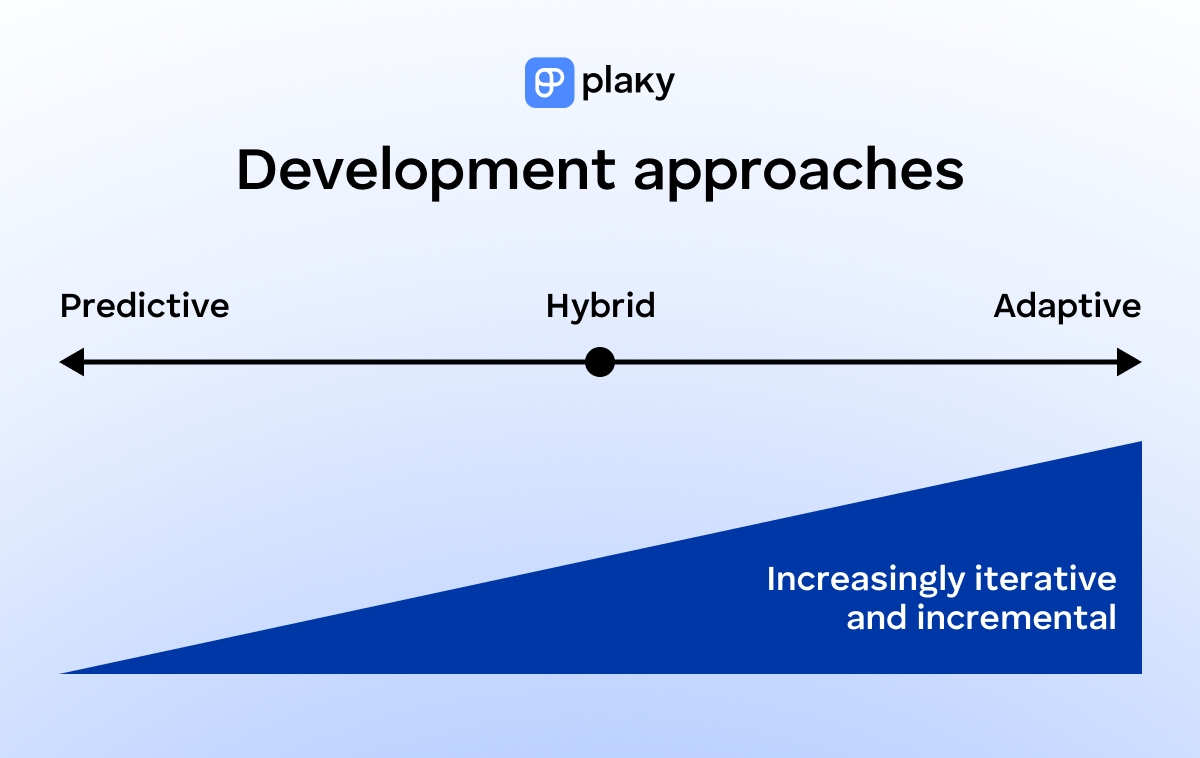
As described by PMI, the process of mixing and adapting elements of different predictive and adaptive approaches is called tailoring.
Since it’s impossible to use a single methodology for all projects to equal effect, project managers use tailoring to craft a hybrid approach that will best fit their current project.
Hybrid project management vs blended project management
Note that hybrid project management is often confused with blended project management.
The difference between them is that:
- Hybrid combines two distinct methodologies, while
- Blended approach combines two frameworks within the same methodology.
For example, a mix of Waterfall and Agile methodologies would create a hybrid approach, while a mix of two different Agile frameworks make a blended project management approach such as Scrumban, which is created by combining elements of Scrum and Kanban.
To illustrate this in a more approachable way, we can once again make use of our zorse analogy.
A zorse is an offspring of a zebra and a horse — a new hybrid species that’s neither a zebra nor a horse. On the other hand, a Morab is a horse you get when you cross a Morgan and an Arabian Horse. While it’s a completely new blended breed, a Morab is still a horse.
Hybrid vs Agile vs Waterfall project management
Notice that we’ve been using the terms adaptive and predictive so far, instead of the more popular Agile and Waterfall, to refer to these approaches. This is because the latter is not entirely correct.
That said, from this point onward, we will refer to these approaches as Agile and Waterfall for the sake of simplicity. But, we’ll also do our best to explain the difference between the 2 confusing naming conventions.
What is Agile (adaptive) project management?
Adaptive project management is an approach that structures work in an incremental, iterative, or Agile (both incremental and iterative) way.
An adaptive approach is used in projects that don’t have well-defined requirements and clear project scope. Instead, the work is performed in short bursts often called sprints. The scope is determined separately for each sprint and in close collaboration with the client.
Because written standards can’t agree on a unified naming system, and the term “Agile” is good enough to cover the general characteristics of adaptive approaches, adaptive project management has gradually become synonymous with Agile and encompasses the following frameworks:
- Scrum,
- Kanban,
- Crystal,
- Extreme Programming (XP),
- Future-Driven Development (FDD), and
- Dynamic Systems Development Method (DSDM), to name a few.
In conclusion, adaptive and Agile are, for all intents and purposes, one and the same.
💡 Plaky Pro Tip
For a more in-depth explanation of Agile project management, take a look at the guide below.
What is Waterfall (predictive) project management?
Predictive, traditional, or Waterfall project management is an approach used in projects that have a clearly defined scope and a clear vision in mind. It puts emphasis on detailed planning and preparing for any number of project risks that might pop up.
In other words, predictive approaches are characterized by:
- Detailed upfront planning,
- Work structured in phases,
- Strict monitoring and control, and
- High level of project governance.
Any approach with these characteristics is considered a predictive approach. This includes methodologies like:
- PRINCE2,
- Stage-Gate, and
- V-model.
That said, due to the unfortunate lack of universal naming conventions in project management, some people refer to predictive approaches as Waterfall, which can get confusing.
However, Agile and Waterfall are the 2 approaches that most people are familiar with, and they manage to encapsulate the characteristics of both adaptive and predictive approaches well enough.
This is why we chose to continue using these 2 terms throughout the rest of this guide, but still decided to explain all of this due to some of the more complex examples of hybrid methodologies you’ll find below.
💡 Plaky Pro Tip
Learn about Waterfall in more detail at the link below.
Waterfall — Agile — Hybrid cheatsheet
After having covered all three approaches, you should now have an idea of what exactly a hybrid project management approach is — an approach that combines detailed upfront planning and documentation with iterative, incremental, and highly-flexible work that focuses on collaboration and customer satisfaction.
But, just in case there are still some uncertainties that need to be cleared up, we’ve prepared a table comparison of these three approaches.
| Category | Waterfall | Agile | Hybrid |
|---|---|---|---|
| Project type | Mostly large projects with clear and fixed requirements and a strict deadline, e.g. construction, manufacturing, engineering, but also software development and design, if the projects allow it. | Smaller, flexible projects, with unclear or changing requirements, e.g. IT, software development, creative and design projects, etc. | Adaptable to any type of project. |
| Planning | Detailed planning before the execution begins. The entire project is planned from beginning to end. | A high-level plan at the beginning of the project, followed by more detailed planning before every iteration (Sprint). | Depends on the project and the type of hybrid approach. Usually, planning is done according to the Waterfall model, but with room left for changes. |
| Change | Changes are unwelcome and difficult to implement. | Changes are expected and part of the process. | Changes can be dealt with using Agile tactics. |
| Scope | Total work is decomposed into smaller tasks within the Work Breakdown Structure (WBS). | A complete list of tasks is kept in the Product Backlog. An iteration backlog is created separately for each iteration. | Work is usually structured in phases. Within the phases, the work is structured in Sprints. This may vary depending on the type of hybrid approach. |
| Budget | Budget is fixed and agreed upon at the beginning of the project. | Budget is relatively flexible. | A total budget estimate is provided at the beginning, but some flexibility is allowed within each project phase. |
| Documentation | Detailed. | Sporadic. | Usually detailed. |
| Roles | Project manager leads the project team. | Sometimes there is a project manager. Usually, projects are led by the Product Owner and Scrum Master, with mostly self-governing teams. | There is always a project manager. Their role is supplemented by that of the Product Owner, Scrum Master, or another agile role, depending on the type of Agile framework chosen for the hybrid approach. |
| Communication with stakeholders | Limited to update meetings. | Constant communication and collaboration. Feedback is essential. | Communication and collaboration are valued and implemented, usually at the end of phases. |
5 types of hybrid project management methodologies
As we’ve already explained, the term hybrid project management may refer to any approach that’s neither fully Agile nor entirely Waterfall. This means that, in theory, the number of unique hybrid approaches could be endless.
However, in their systematic review of literature on hybrid project management, Reiff and Schlegel noticed 4 distinct hybrid methodologies that stood out:
- Water-Scrum-Fall,
- Waterfall-Agile,
- Hybrid V-model, and
- Agile-Stage-Gate (Scrum-Stage-Gate).
Additionally, there’s a very common fifth hybrid project management approach — the parallel approach — that we’ll also discuss in this section.
Type #1: Water-Scrum-Fall
As the name suggests, the Water-Scrum-Fall methodology is a combination of Waterfall and Scrum.
First suggested by Dave West in 2011, as the reality of Agile in most organizations, Water-Scrum-Fall describes a methodology where the project begins and ends with Waterfall, while the iterative Scrum is used in the execution phase.
In other words, the entire requirements gathering and planning processes, including detailed documentation, are done using Waterfall.
This is followed by the execution phase where the product is created in iterative Sprints until the final deliverable is complete.
The project ends with the implementation and testing phases once again performed using strict Waterfall processes.
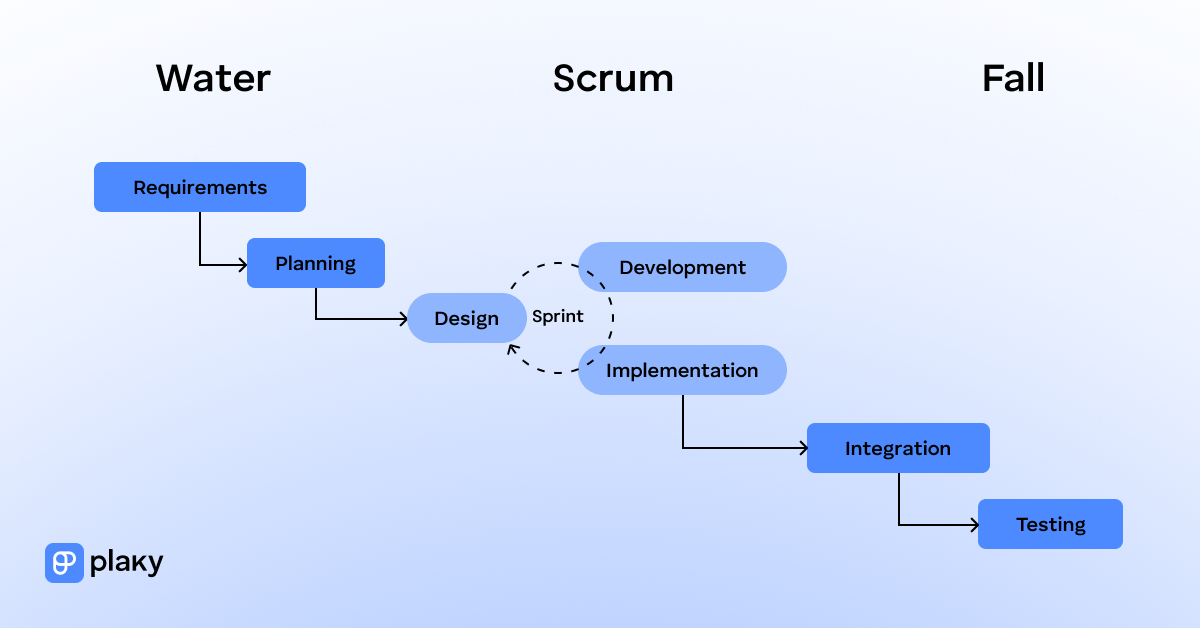
Since the methodology uses Scrum as part of its process, there are two additions to the project team — the Scrum Master and Product Owner who make sure that development goes smoothly.
💡 Plaky Pro Tip
To learn about the most notable differences between Scrum and Waterfall, check out the following guide:
Type #2: Waterfall-Agile
The Waterfall-Agile hybrid methodology is similar to the Water-Scrum-Fall in that it begins with Waterfall-type planning and then flows into the execution phase that is done using an agile approach.
The main difference is that, in Waterfall-Agile, the implementation and testing phases are also performed in an agile manner.
More simply put, all the planning is done using strict Waterfall processes, while the rest of the project is performed using an agile approach — typically Scrum.
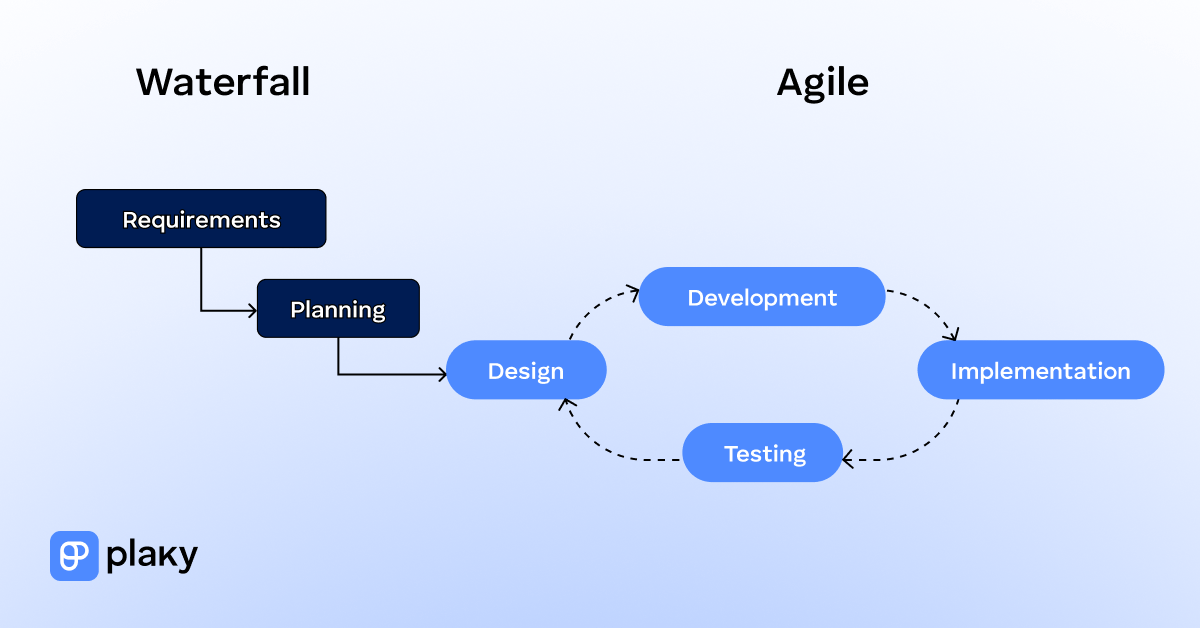
An interesting thing about Waterfall-Agile is that there is no strict line that defines when Waterfall ends and Agile begins — this is left up to the project manager.
When it comes to the project roles, the main decision-maker in the Waterfall part of the project is still a project manager. The other necessary roles within the agile part are taken up by various team members throughout the project.
Type #3: Hybrid V-model
Like the Water-Scrum-Fall, the Hybrid V-model begins and ends with a traditional approach, with agile (usually Scrum) once again being used for development. The difference is that this hybrid uses the V-model methodology instead of Waterfall.
Interestingly enough, the V-model is a traditional approach that was created for software development. Just like Waterfall, it structures work in phases, but it encourages feedback and collaboration and allows returning to the previous phase.
The name of the V-model is derived from its V-shaped structure where the left-hand side is dedicated to requirements gathering and planning, and the right-hand side to testing.
Each of the defined requirements on the left slope must have a corresponding testing task on the right slope to ensure all requirements have been implemented and checked.
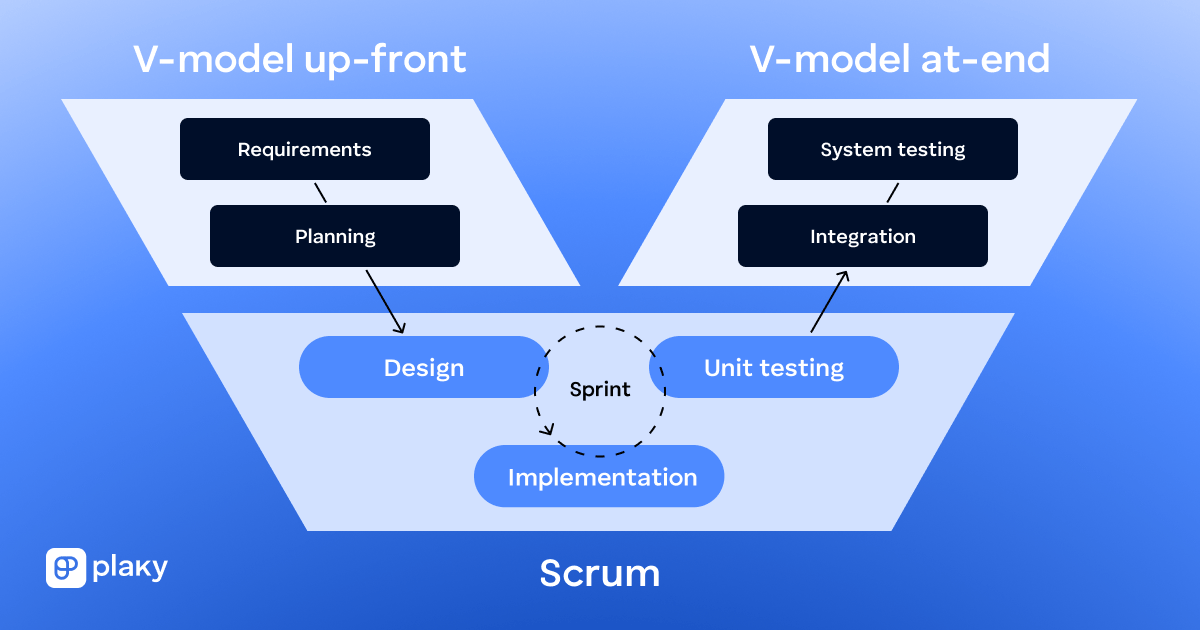
In the hybrid version, the traditional V-model practices are applied only:
- At the beginning (requirements gathering and planning) and
- At the end of the project (integration and system testing).
The development phase that lies at the bottom of the V diagram is performed using Scrum and incorporates testing in each iteration instead of waiting for the coding to be complete before tests can begin.
Type #4: Agile-Stage-Gate (Scrum-Stage-Gate)
The Agile-Stage-Gate hybrid is a combination of the basic Stage-Gate principles and Agile practices. Most often, the Agile framework combined with Stage-Gate is Scrum.
Stage-Gate is a basic system of project stages or phases and metaphorical gates the team needs to go through to mark a stage finished and proceed to the next one.
As its creator, Dr Robert Cooper, explains, the main idea of Stage-Gate is that the project manager plans and collects money on a per-stage basis. In other words, each stage is treated like a separate mini-project as a way of mitigating risks.
The Agile-Stage-Gate hybrid adds flexibility to the more traditionally structured Stage-Gate approach by incorporating a string of Sprints into each stage. The goal is to:
- Collaborate with users,
- Provide them with something tangible as soon as possible, and
- Improve on it throughout the stage.
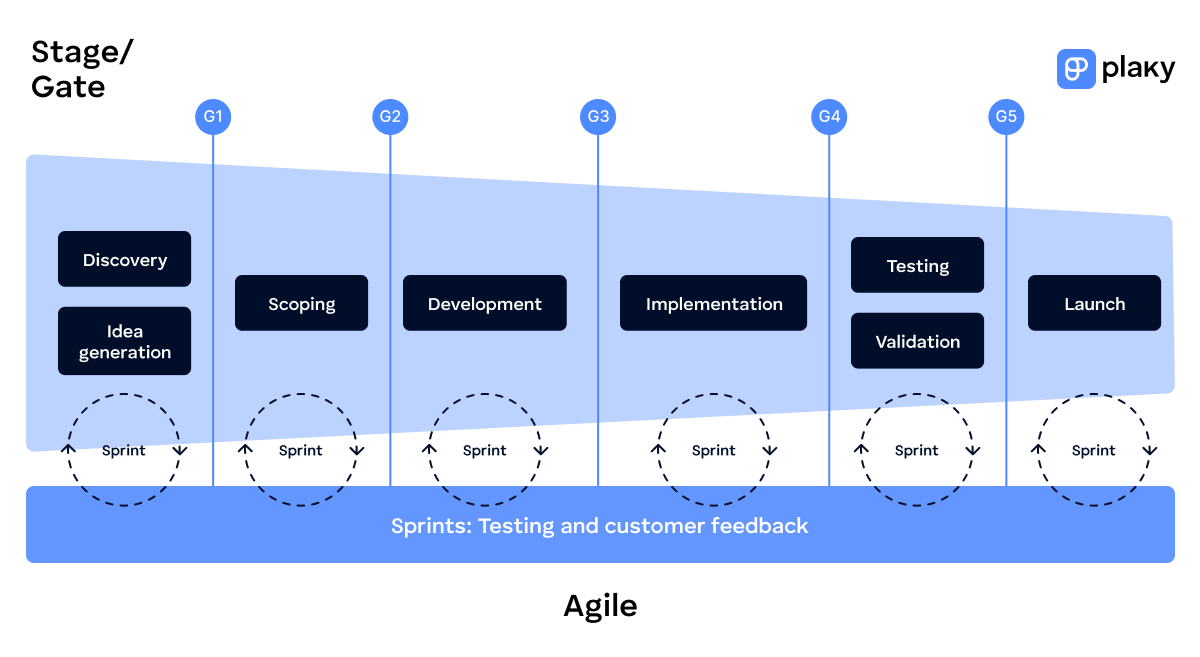
Type #5: Parallel approach
Parallel approach is not an approach described in the abovementioned literature review, but it’s one of the very common uses of hybrid project management. Namely, it’s possible to use Agile and Waterfall alongside one another.
Take the creation of a new smartphone, for example.
The project requires the teams to create both software and hardware to get a finished product. In this case, it’s very common for software development teams to use an Agile approach, and the hardware development team to use a Waterfall approach — all while working on the same project and under the same project manager.
When to use hybrid project management
Hybrid project management has become quite the buzzword in the PM community in recent years, and for good reason — it’s a great way to circumvent many of the risks that come with rigidly sticking to only one approach.
However, this doesn’t mean it will work for everyone. Instead, according to the previously mentioned paper by Reiff and Schlegel, the hybrid approach is best suited for:
- Extremely large organizations,
- Large cross-functional teams,
- Large and complex projects,
- Uncertain and risky projects,
- Heavyweight innovation projects, and
- Software development projects.
While hybrid project management can be used in small and medium-scale companies and projects, this often isn’t necessary since straightforward methodologies get the job done.
Small companies that mainly deal with standardized projects that follow a clear pattern and have clearly defined requirements most likely use some type of a traditional approach and it probably works well. To suddenly switch things up just because all the cool kids do it would only cause unnecessary chaos.
The same goes for smaller, fully Agile teams whose project success heavily relies on their ability to cater to their demanding clients.
That said, due to its adaptable nature, hybrid project management can be used in any company or project, regardless of its size or complexity. Whether the challenge of implementing it is worth it is a whole different discussion.
How to craft your perfect hybrid approach
Say you’ve weighed your options and decided that a hybrid approach would be the ideal solution for your project. However, you’re not sure which methodologies to combine and how to structure the ratio of Agile to traditional elements.
In this case, you can ask yourself some basic questions about the project that should help you reach a decision.
First off, it would be wise to take a look at the external factors that influence the project. It’s only after you’ve gotten the basics out of the way that you can move on to asking questions about the nature of the project itself, to paint a clearer picture of what your hybrid project approach should look like.
Step #1: Analyze the external project circumstances
First of all, you should take a look at your own experience in project management and that of the people close to the project. Here are some questions you can ask yourself:
- Which methodologies are you familiar with? — Transitioning to a hybrid model is not easy, especially if it’s your first time using one or both of the methodologies you’re combining. So, make sure you’re proficient in the methodologies you plan to combine.
- What methodologies is your team familiar with? — Similarly, you should be aware of the skills and experience of the people on your team. If it would take longer to educate the team and make them get used to new processes than to finish the entire project, the transition might not be worth the effort.
- Which methodologies are your stakeholders willing to accept? — Your projects depend a great deal on your key stakeholders. If your executive management, client, or project sponsor are not willing to dive into uncertainty with you, it will be difficult to make the hybrid approach work.
- Are your project management skills up to par? — Can you handle not only leading a project, but also introducing new concepts and processes and getting everyone motivated and on board with the new way of doing things? Another thing to consider is that you ought to have superb planning skills to be able to switch methodologies from project to project and still keep the quality from dipping.
Step #2: Analyze the project
Asking the questions from step 1 should already drastically narrow down your choices. Next, it’s time to take a look at the project itself.
- What is the type of project you’re working on? — Different kinds of projects in different industries lend themselves better to different approaches. While hybrid project management can function in virtually any environment, understanding the project and its strengths and weaknesses will help you pick the right elements to construct your unique approach.
- How clear are the project requirements and the final goal? — A project with its goal, budget, and deadline set in stone will lean toward Waterfall, while more flexible requirements and constraints will work better with a more Agile approach with only a little bit of Waterfall thrown into the mix.
- Will your team members work on one or more projects at once? — If your team members will be stretched across several projects, consider that all of those projects might use different approaches. Adding another one into the mix without considering their current workflow might only cause confusion and negatively affect their performance.
—
Once you answer all of the questions above, you should have a clearer understanding of what your hybrid approach should look like. The answer could be one of the 5 types of hybrid methodologies described earlier in this guide, or it could be your own unique approach.
Regardless of what it is, you should further discuss the details of its implementation with your project team. Since they are the ones who will be doing all the work, they will be able to tell you with more certainty whether things will or will not work the way you envisioned them.
How to implement a hybrid approach in your organization
After you’ve drawn up the strategy with your team, Wellingtone suggests you follow these steps next to implement it in your organization:
- Define roles and responsibilities — since roles and responsibilities are going to change after combining approaches, it’s best that you clarify them at the very beginning to avoid confusion once the project is already underway.
- Create capabilities — all team members should have at least a basic understanding of the methodologies they will be using. But, why settle for basic understanding when you can train your team to recognize the best processes to use according to the type of project they’re working on.
- Do a trial run — be at peace with the fact that you’ll never get it right the first time. So, it’s always better to start small — try it, see what works, what doesn’t, fix it, then try again.
- Find your champions — Wellingtone describes champions as people within the organization who have the power to change people’s mindset. The idea is to adapt the entire company culture to the new approach and, for that, you need people who are willing to support you and encourage a new and more flexible way of thinking.
Hybrid project management example
Theory is all well and good, but how does hybrid project management actually work in practice?
Here’s an example of a hybrid approach in action in an organic baby food company called Ella’s kitchen.
Ella’s kitchen was a disorganized mess without any formal project management processes in place.
Ellen Jarret, the new program manager who was hired to set things in order, decided that hybrid project management was the right choice for the company.
In her interview with APM, she said: “We run the team, tolerances and change requests in a PRINCE2-type way, but everything isn’t set in stone at the beginning, because things change so much at every stage.”
The company normally deals with two kinds of projects — product projects and internal projects.
Internal projects are normally led using a PRINCE2 methodology. The teams follow a highly structured process of going through predetermined phases, and the work is performed in order.
Product projects are run using a hybrid of PRINCE2 and Agile across 5 stage gates:
- Business analysis,
- Gate document,
- In-house sample creation,
- Factory process, and
- Review of product.
Jarret further organized the company’s processes to better fit their new hybrid approach by introducing the teams to project tracking software.
Where the company used to have 40 projects running at the same time and stretched over 60 people, and all their schedules, deadlines, tasks, and information stored in 40 different Excel files, they could now easily keep track of their tasks and progress on one platform.
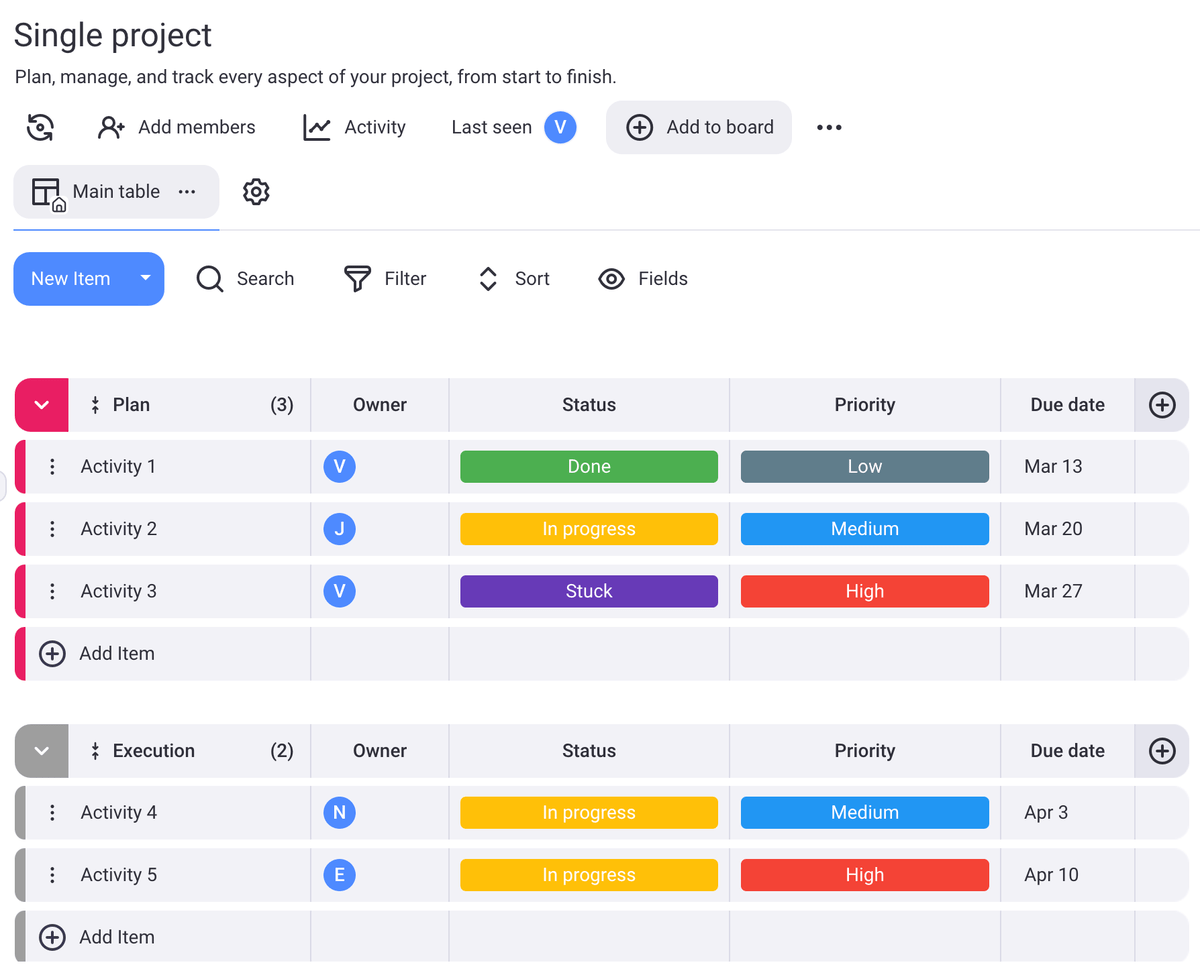
Hybrid project management benefits
Hybrid project management has become rather popular lately.
In fact, a 2021 survey of 220 project managers revealed that 60% of respondents use a hybrid approach to run their projects.
Here are some of the reasons that make hybrid the most commonly used approach:
- Adaptability — the hybrid approach allows project managers to tailor their systems and processes to fit any project like a glove. Hybrid project management also leads to better outcomes since its flexibility allows project managers to pivot and adapt ongoing projects according to their current status.
- Reduced project risk — being able to pick and choose the elements of Agile and Waterfall they wish to incorporate into their projects, project managers can strategically alter their methodology to exclude processes that carry the most risk, thereby minimizing the chances of project failure.
- Increased transparency and collaboration — in cases where Agile is introduced to a previously traditional project environment, it forces the project to become more transparent and incorporate more feedback and collaboration both with the stakeholders and within the project team.
- Increased creativity — two heads are better than one. More open communication in hybrid versus traditional environments improves problem-solving and creativity across the board.
- Boosted efficiency — thanks to the wide selection of tools available within hybrid approaches, it’s easier to find the right one for any given project. This often leads to finding better solutions to problems, lowering project costs, and completing tasks more quickly with better-quality outcomes.
- Increased motivation of project teams — in cases where projects introduce Scrum to an otherwise traditional environment and shed conventional project roles, team members gain a higher emotional stake in the project. The project becomes a shared responsibility of the team, which increases their motivation to perform well.
Hybrid project management challenges
Hybrid may sound like the perfect approach, but it’s not without its challenges. Here are some examples of difficulties you may encounter when trying to switch to hybrid project management:
- It’s difficult to teach an old dog new tricks — not everyone is equally receptive to change. Changing a project management approach in an organization that has used one method for decades can be extremely challenging. Sometimes, this is because people find it difficult to get used to new ways, and sometimes, because they consciously resist it.
- Switching to a new approach takes time — as mentioned above, change is never easy. It takes dedication and willingness from all parties involved. Transitioning to hybrid project management also often requires a lot of trial and error, which takes quite a bit of time in project management.
- Misplaced expectations from executive management — when uprooting the way the project management team functions in an organization, the stakeholders and executive management must be fully on board. If they’re insufficiently informed about the changes that are happening, they will have wrong expectations, which will create serious issues and misunderstandings during project development.
- Conflicts within the project team — adoption of Agile principles comes with increased communication and transparency. While this has its fair share of benefits, it also means that teams are encouraged to publicly share ideas and opinions — something that can easily lead to conflicts between team members if not managed properly.
Conclusion: The hybrid approach improves project flexibility
In an evolving market where fast output and innovation are highly valued, traditional project management approaches are slowly giving way to more adaptive methods. Mixing and merging with Agile frameworks, they create hybrid project management methodologies that are faster, stronger, and more flexible.
But, while using hybrid methodologies will likely have strong positive effects on organizations, making the transition to hybrid is not as easy as it seems. So, it’s best to double down on planning if you intend to switch to a hybrid model.
📖 Now that you’ve read all about hybrid project management, maybe it’s time to delve deeper into project management terminology — explore our Project Management Glossary of Terms.
How we reviewed this post: Our writers & editors monitor the posts and update them when new information becomes available, to keep them fresh and relevant.

